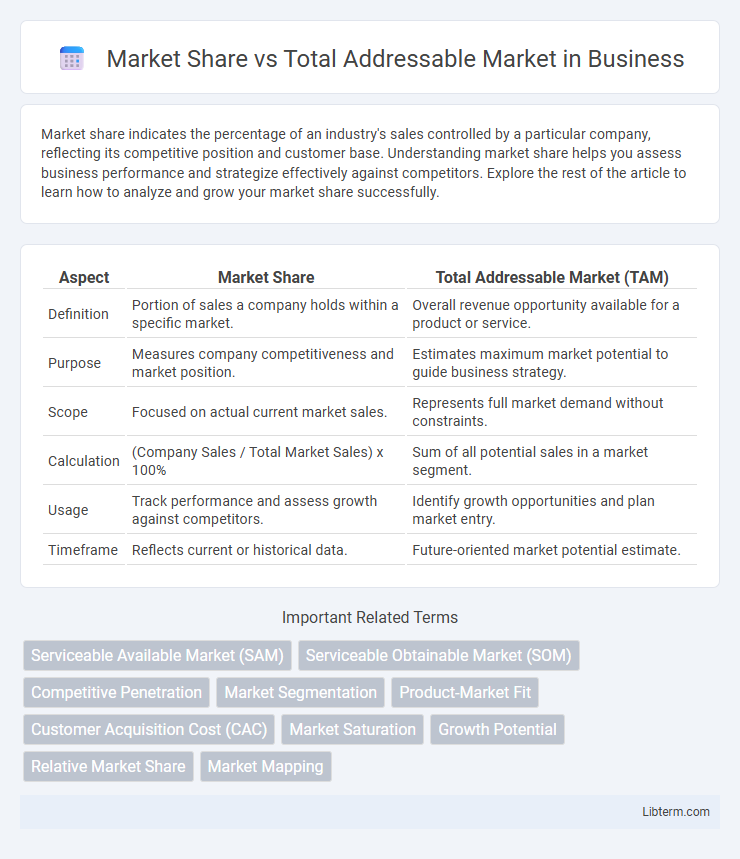Market share indicates the percentage of an industry's sales controlled by a particular company, reflecting its competitive position and customer base. Understanding market share helps you assess business performance and strategize effectively against competitors. Explore the rest of the article to learn how to analyze and grow your market share successfully.
Table of Comparison
| Aspect | Market Share | Total Addressable Market (TAM) |
|---|---|---|
| Definition | Portion of sales a company holds within a specific market. | Overall revenue opportunity available for a product or service. |
| Purpose | Measures company competitiveness and market position. | Estimates maximum market potential to guide business strategy. |
| Scope | Focused on actual current market sales. | Represents full market demand without constraints. |
| Calculation | (Company Sales / Total Market Sales) x 100% | Sum of all potential sales in a market segment. |
| Usage | Track performance and assess growth against competitors. | Identify growth opportunities and plan market entry. |
| Timeframe | Reflects current or historical data. | Future-oriented market potential estimate. |
Understanding Market Share: Definition and Importance
Market share represents the percentage of total sales in an industry generated by a particular company, serving as a critical indicator of competitive position and business performance. Understanding market share helps businesses identify growth opportunities, assess market dominance, and benchmark against competitors within the total addressable market (TAM). Accurate measurement of market share guides strategic decisions, resource allocation, and marketing efforts to maximize revenue potential and enhance market presence.
What Is Total Addressable Market (TAM)?
Total Addressable Market (TAM) represents the total revenue opportunity available for a specific product or service if it achieved 100% market penetration. It quantifies the maximum demand within a target market, guiding businesses in strategic planning and investment decisions. Accurate TAM estimation helps companies identify growth potential and allocate resources effectively to capture market share.
Key Differences Between Market Share and TAM
Market share quantifies a company's sales as a percentage of total industry sales within a specific market, reflecting competitive positioning and operational success. Total Addressable Market (TAM) measures the overall revenue opportunity available if a company captures 100% of the market demand for its products or services. Key differences include market share representing actual achieved sales while TAM indicates potential market size, with market share offering insights into competitive standing and TAM guiding strategic growth opportunities.
Calculating Your Market Share
Calculating your market share involves dividing your company's total sales revenue by the total sales revenue of the entire market for the same product or service, then multiplying by 100 to get a percentage. This metric provides insight into your competitive position and effectiveness in capturing demand within the Total Addressable Market (TAM). Accurate market share analysis requires precise data on overall market size, which can be derived from industry reports, government statistics, or market research firms.
Estimating Total Addressable Market for Your Business
Estimating Total Addressable Market (TAM) for your business involves quantifying the total revenue opportunity available if your product or service captures 100% market share. Analyze industry reports, competitor performance, and customer demographics to determine TAM accurately. Understanding TAM helps identify growth potential and guides strategic planning to maximize market penetration and share.
Why Market Share Matters for Growth Strategies
Market share reflects a company's current position within its Total Addressable Market (TAM), indicating how much of the potential market demand it effectively captures. Understanding market share is crucial for growth strategies because it highlights competitive strengths, identifies market penetration levels, and exposes opportunities for expansion or improvement. Businesses leverage market share data to allocate resources efficiently, tailor marketing efforts, and forecast revenue growth based on actual market dynamics rather than theoretical potential.
How TAM Guides Business Expansion Plans
Total Addressable Market (TAM) provides a comprehensive estimate of potential revenue available, serving as a critical benchmark to identify growth opportunities and prioritize market segments. Understanding TAM enables businesses to allocate resources efficiently, tailor product development, and design targeted marketing strategies to capture untapped customer bases. Market share analysis within the context of TAM helps gauge current performance and set realistic expansion goals aligned with overall market potential.
Common Misconceptions About Market Share vs TAM
Market share is often mistaken for the total addressable market (TAM), yet these metrics represent different scopes; market share reflects a company's sales relative to competitors within a segment, while TAM denotes the overall revenue opportunity available for a product or service. A common misconception is assuming a high TAM guarantees market dominance, ignoring factors like competition, consumer behavior, and operational capacity that constrain actual market share. Businesses must differentiate between TAM as a strategic growth indicator and market share as a performance metric to avoid overestimating market potential.
Using Market Share and TAM in Competitive Analysis
Market share quantifies a company's sales as a percentage of the total sales within a specific market, providing insight into competitive positioning and customer preference. Total Addressable Market (TAM) represents the overall revenue opportunity available for a product or service, helping businesses identify growth potential and strategic market entry points. Combining market share with TAM in competitive analysis enables companies to evaluate current performance against market opportunity, identify underserved segments, and prioritize resource allocation for maximum market penetration.
Integrating Market Share and TAM for Data-Driven Decision Making
Integrating Market Share and Total Addressable Market (TAM) enables businesses to evaluate their current position while identifying growth opportunities within the full market potential. Analyzing Market Share alongside TAM provides critical data for strategic planning, resource allocation, and forecasting revenue streams effectively. Leveraging this integration supports data-driven decision making by aligning product development and marketing efforts with both existing customer base insights and untapped market segments.
Market Share Infographic

 libterm.com
libterm.com